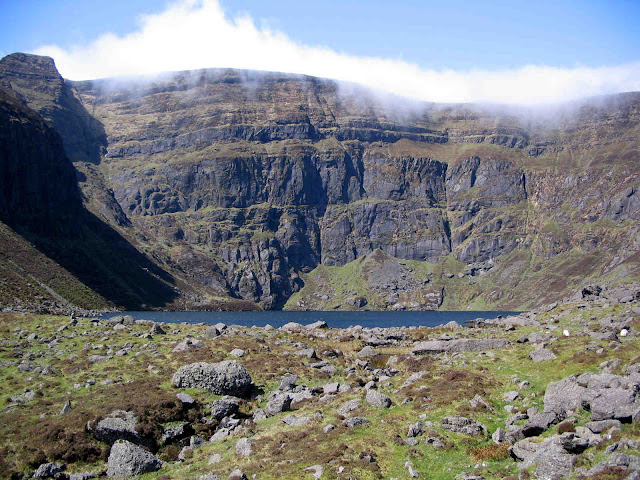The Mahon Valley
 |
| Mahon Falls and Knockaunapeebra from the saddle on Comeragh Mountain |
The Mahon Valley is unquestionably one of the most dramatic and scenic places in the Comeraghs. Driving up the valley from Mahon Bridge at the bottom to Mahon Falls at the top you find yourself growing ever more enchanted by the awe-inspiring vistas of this magnificent glacial valley. Better still, why not walk up along the Crough Wood Trail for a while and then continue to the top on the winding road to take in the many features of this magnificent valley?
Glaciated Valley Par Excellence
Along with the Nire Valley the Mahon Valley is considered to be one of the best examples of a glaciated valley in the Comeraghs. It is over 3 kilometres long, 600 to 800 metres wide, and stretches from Mahon Falls in the north to Crough Wood and Croagh Hill near Mahon Bridge in the south. It drops in elevation from about 400 metres at the Falls to 200 metres at the mouth and possesses the classic u-shaped profile of a valley which has been glaciated. However, though it is cliff-lined along its back and sides and has truncated spurs chiselled out by the ice, it doesn`t have the classic lake or moraines that glaciers often leave behind them. It does have plenty erratics though, many of them to be seen at the base of the Falls. There is also a lot of loose scree, especially noticeable at the bottom of its north-eastern cliffs.Other Features in the Valley
Comeragh Saw Mill: This can be seen near the start of the Crough Wood Walk. The mill was owned by the Pallisers, lords of Comeragh in the 19th century, and Bob Weldon, the bard of the Comeraghs once worked there.The Scurras: This is the name given to the serrated rocky ribs seen along the lower eastern wall of the valley. The word probably originates from the Scots Gaelic word “Sgurr” which means rocky peak.e.g. Sgurr Alistair, the highest peak on Skye.
Knockaunapeebra: This is the cone-shaped hill that dominates the north-eastern corner of the Mahon Valley. The name comes from “Cnocán an Phíobaire” which means the hillock of the piper and is so named, reputedly, after a piper who lost his way and died here in the 19th century.
Comeragh Mountain: If Knockaunapeebra and the Scurras delineate the valley to the east, Comeragh Mountain does so to the west. It is essentially a shoulder or spur that descends for almost 3 kilometres from the Comeragh Plateau to Crough. The first 500 metres along the upper reaches has sheer cliffs, 500 metres later the shoulder is crossed on a saddle by a minor road. Below the saddle it consists of two elongated hills – Davmore and Davbeg (from “Damh” which means ox).
The Magic Road: This is a short stretch of road just above the sheep grid where the Crough Wood Walk exits onto the road. It is called the “Magic Road” it seems because stationary cars here apparently move uphill! (optical illusion surely?!)
The River
The Mahon Óg is the main tributary of the Mahon and can be seen clearly descending off the plateau to the right between the Scurras and Knockaunapeebra. It is a useful handrail for anyone who wants to reach “792”/Kilclooney Mountain, the highest point on the Comeraghs, for it begins its journey in the boggy ground on its south-eastern flanks. About a kilometre higher up the valley, again on its eastern side, is another noticeable stream, this one is often called the Mahon Beag.The headwaters of the Mahon itself rise on the Comeragh Plateau and have created a little intermontane basin before joining and tumbling down over 200 metres to the valley below, creating one of the most picturesque waterfalls in Ireland.
What`s in a Name
Mahon is the anglicized version of the Irish name "Mathún". Mathún was a common name amongst the O`Briens of Thomond, some of whom came to to the Comeragh area in the early 15th century, having been given land there by the Earl of Desmond.






Comments
Post a Comment